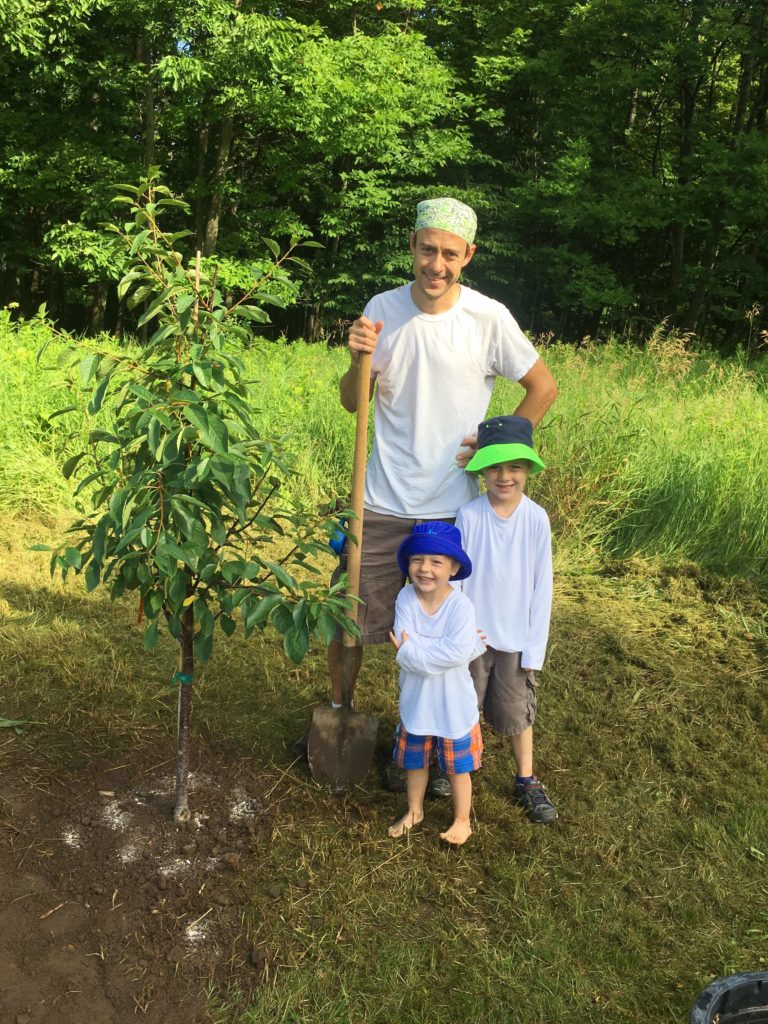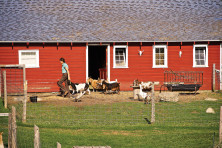Dirty Feet: A Journey to Homesteading
- Share
- Tweet
- Pin
- Share

by Angela Sherman
As a child, I helped my grandmother fill her basement with colorful cans, and I have fond memories of picking beans – though eating more green beans than I’d put in my great-aunt’s brown paper bags. Over the years, I’ve learned that homesteading is both of those things: producing your own food and preserving it for out-of-season enjoyment.
One of my favorite things is working in the garden with my kids. Ensuring that they know where their food comes from is so important to me. Every year our garden looks a little bit different. When one crop doesn’t work well or yield enough for our preserving needs, we find a friend who grows that crop, or we buy from our CSA or local organic farmers. This year we’re going to let the kids use some newly available space to try growing corn.
Chicken-proofing the garden and orchard were required once we decided to expand our homestead. Originally we wanted four to six chickens, but a friend told us to get extra because some might die. We decided late and couldn’t buy any locally, so we had to buy our birds by mail: a 15-bird minimum order plus a free “mystery bird.” I ran to the post office as soon as they called to say that my package was chirping. We only lost one bird: adventurous Rosie, who refused to stay in the fence and was spotted by a hawk.
Our coop was not built for such a large flock, so we had to improvise. In a few afternoons, Ryan and the two older sons worked on putting together pallets, running chicken wire and putting on a tarp roof. They also built another set of nesting boxes for the additional run space. In winter, they use old windows to create a wind and snow barrier.

nesting boxes. Photo by Angela Sherman.
We designed our garden to deter animals by planting garlic and herbs around the outside. We learned that chickens love to play in mulch and dig in the dirt, so having an open area around the garden was devastating to our plants. Two-inch chicken wire worked great to deter the chickens. We also used two-inch chicken wire around the main garden but didn’t take into account how easily bunnies can fit through a stretched, two-inch hole. Ryan was able to overlay one-inch chicken wire, which has kept the bunnies out.
Our homesteading journey took a new step last fall when a friend gave us roosters and we had our first butchering experience.
Ryan and I set up our supplies, and the kids picked their jobs (dumping the water bucket). The kids even created a song, “Thank you, roosters, for being our food; thank you, roosters, for being our food; you’re super delicious and very nutritious; thank you, roosters, for being our food.”
In addition to canning, freezing and dehydrating produce, I make a variety of products. From lip balm to elderberry syrup and even baby wipes, I try to reduce our use of commercially made products in favor of homemade, simple-ingredient options.
As they get older, my kids have been able to take a more active role in our homesteading. Theo loves feeding the chickens; Mylo is a bean-picking and egg-collecting expert; and they both relish the days we spend in the kitchen canning, baking and cooking together. Enzo is still young, but he is a great cheering section, both from his high chair and his outside play yard. Whenever they get invited to birthday parties, they excitedly pick a jar or two from the pantry to give as a gift, and Theo always says, “Who wouldn’t want a homemade present?”
I don’t know who likes our homesteading lifestyle more, the kids or me. When bad weather approaches, we don’t rush to the grocery store. Instead, we head to the pantry to restock the cupboards and to the freezers to refill the fridge. The winter reward is worth the spring, summer and fall dedication.
Tips for Getting Started
• Start small. Don’t try to overwhelm yourself by doing too much your first year. Add new things every year to make the expansion feel less daunting.

Ryan’s mom, Gramma Sue. Photo by Angela Sherman.
• Plant fruit trees and bushes as soon as possible. If there’s one regret I have, it’s that we waited so long to plant our orchard and fence it in. These take many years to establish and bear large amounts of fruit.
• Get to know other homesteaders and farmers. It helps to know other people who are engaging in the same activities, both for options to purchase and to share information. If you’re lucky, you may even have friends who like to barter!
• Don’t be afraid of change. If something isn’t working, try a new crop or a different technique. Don’t be afraid of switching things up regularly.
• Eat in season. Preserving produce during its growing season will yield year-round deliciousness.
• You don’t need a manicured yard. Over the years, we have reduced our mowed lawn in favor of fenced-in growing areas, a chicken coop, a small greenhouse and restored natural meadow spaces.
• Buy whole, half or quarter animals. If you’re unable to raise your own animals, the best way to buy is in bulk. Purchasing whole or portions of whole animals provides the best price.
• Diatomaceous earth is your friend. We have found that it’s a great natural option for bug problems. We apply it at night, after the evening water when no rain is predicted – it’s not effective when wet.
• Install a watering system. Having to remember to water can be challenging, making an investment in a watering system worth every penny. We use a half-inch hose around the outside of the garden and connect eighth-inch tubes with drip holes spaced six inches apart. It’s set to run twice a day and manually delayed during rain.
• Compost, compost and more compost. We buy a few yards of compost each year to apply in the fall, spring and between crop harvests. We use a broad fork to turn the dirt and mix in the compost.
• Get dirty. Walk with bare feet and work without gloves.
• Have fun! Even on nights when our oldest was a baby and we’d stay up until 3 am canning, we always tried to have a smile on our faces.


